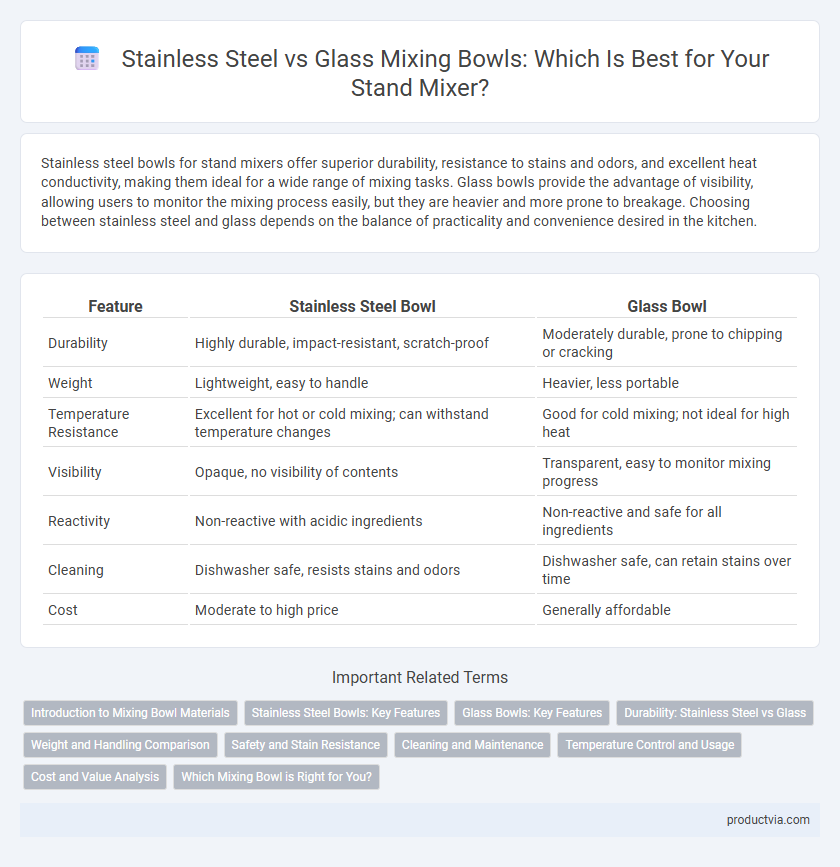Stainless steel bowls for stand mixers offer superior durability, resistance to stains and odors, and excellent heat conductivity, making them ideal for a wide range of mixing tasks. Glass bowls provide the advantage of visibility, allowing users to monitor the mixing process easily, but they are heavier and more prone to breakage. Choosing between stainless steel and glass depends on the balance of practicality and convenience desired in the kitchen.
Table of Comparison
| Feature | Stainless Steel Bowl | Glass Bowl |
|---|---|---|
| Durability | Highly durable, impact-resistant, scratch-proof | Moderately durable, prone to chipping or cracking |
| Weight | Lightweight, easy to handle | Heavier, less portable |
| Temperature Resistance | Excellent for hot or cold mixing; can withstand temperature changes | Good for cold mixing; not ideal for high heat |
| Visibility | Opaque, no visibility of contents | Transparent, easy to monitor mixing progress |
| Reactivity | Non-reactive with acidic ingredients | Non-reactive and safe for all ingredients |
| Cleaning | Dishwasher safe, resists stains and odors | Dishwasher safe, can retain stains over time |
| Cost | Moderate to high price | Generally affordable |
Introduction to Mixing Bowl Materials
Stainless steel bowls offer durability, resistance to stains and odors, and excellent temperature control, making them ideal for frequent baking and heavy-duty mixing tasks. Glass bowls provide a clear, non-reactive surface that allows easy monitoring of ingredients during mixing and is microwave-safe for melting or warming. Choosing between stainless steel and glass depends on factors like weight preference, thermal conductivity, and the need for visual clarity during preparation.
Stainless Steel Bowls: Key Features
Stainless steel bowls are favored for their exceptional durability, resistance to stains, and ability to withstand high temperatures without warping. They provide excellent non-reactive surfaces that do not retain odors or flavors, making them ideal for diverse mixing tasks. Lightweight and often equipped with non-slip bases, stainless steel bowls offer enhanced stability and ease of handling during intensive mixing processes.
Glass Bowls: Key Features
Glass mixing bowls offer excellent visibility, allowing users to monitor ingredient blending and consistency without lifting the lid. They are non-reactive, ensuring that acidic or alkaline ingredients do not alter the taste or color of the food. Additionally, glass bowls are dishwasher safe and resistant to staining and odors, making them a hygienic and low-maintenance option for stand mixer use.
Durability: Stainless Steel vs Glass
Stainless steel bowls offer superior durability due to their resistance to dents, scratches, and breakage, making them ideal for heavy-duty mixing tasks. Glass bowls, while visually appealing and non-reactive to acidic ingredients, are prone to cracking or shattering under impact or sudden temperature changes. Choosing stainless steel enhances long-term use and reliability in various cooking environments.
Weight and Handling Comparison
Stainless steel mixing bowls are significantly lighter than glass bowls, making them easier to handle and maneuver during mixing tasks. Their lightweight nature reduces strain on the stand mixer's motor, enhancing performance and durability. In contrast, glass bowls are heavier and bulkier, which can make handling more cumbersome and increase the risk of accidental drops or spills.
Safety and Stain Resistance
Stainless steel bowls offer superior safety due to their durability and resistance to breaking or cracking, making them ideal for heavy-duty mixing tasks. They also excel in stain resistance, preventing discoloration from acidic or strongly pigmented ingredients commonly encountered in baking. Glass bowls provide visibility for mixing progress but are more prone to chipping and staining, which can compromise long-term safety and aesthetic appeal.
Cleaning and Maintenance
Stainless steel bowls for stand mixers are highly durable, resistant to stains, and can withstand frequent washing without retaining odors, making cleaning straightforward and low-maintenance. Glass bowls offer the advantage of being dishwasher safe and non-reactive with acidic ingredients, but they require careful handling to avoid chips and cracks during cleaning. Choosing stainless steel enhances long-term durability with minimal upkeep, while glass provides visual monitoring of mixing progress with slightly increased maintenance considerations.
Temperature Control and Usage
Stainless steel bowls excel in temperature control, quickly adapting to cold or hot ingredients, which is ideal for delicate recipes requiring precise temperature management. Glass bowls offer superior visibility during mixing and retain temperature longer but are slower to adjust to temperature changes, potentially affecting recipes sensitive to warmth. Choosing between stainless steel and glass depends on the need for rapid temperature adaptation versus steady heat retention during mixing tasks.
Cost and Value Analysis
Stainless steel bowls for stand mixers offer superior durability and resistance to stains and odors compared to glass bowls, providing better long-term value despite a higher initial cost. Glass bowls are more affordable and allow visual monitoring of mixing but are prone to chipping and breakage, which can increase replacement costs over time. Evaluating cost against longevity, stainless steel emerges as the more cost-effective choice for frequent bakers seeking a durable and reliable mixing bowl.
Which Mixing Bowl is Right for You?
Stainless steel bowls offer superior durability, resistance to stains and odors, and excellent temperature control, making them ideal for heavy-duty mixing and frequent use. Glass bowls provide clear visibility of contents, are non-reactive, and microwave-safe, which benefits delicate tasks like melting or proofing dough. Choose a stainless steel bowl for longevity and versatility or a glass bowl for transparency and multi-functionality in your stand mixer setup.
Stainless steel bowl vs Glass bowl for mixing bowl material Infographic

 productvia.com
productvia.com